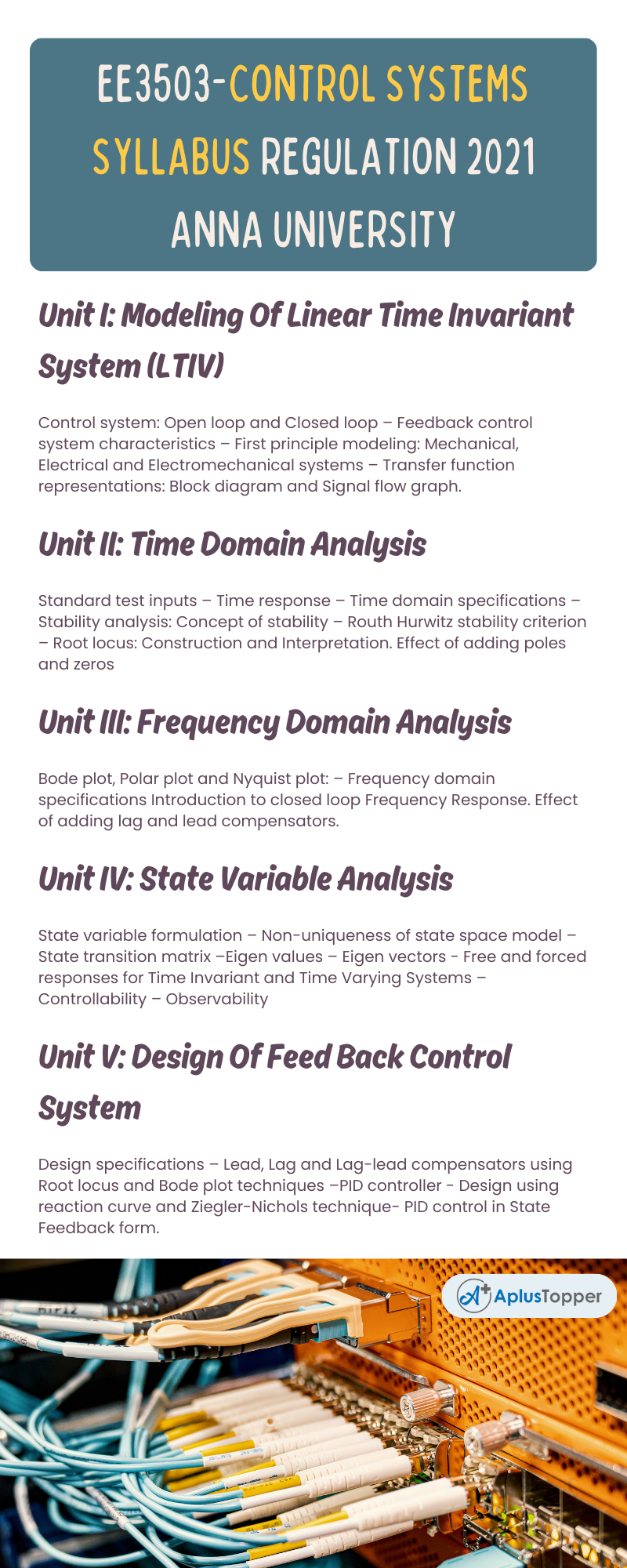The article contains the subject code EE3503, which deals with the Anna University B.E Electrical and Electronics Engineering Semester –V Control Systems Syllabus. Unit-wise detailed syllabus of this subject EE3503 is included in this article. You can get assistance for note preparation or can understand the chapters contain topics in one place.
Effective results need effective preparation and having the required knowledge of the topics included in the subject. If you want to perform well in academics proper guidance and the subject syllabus in mind are necessary, this article EE3503 – Control Systems Syllabus will fulfill the details regarding your preparation.
If you want to know more about the syllabus of B.E Electrical and Electronics Engineering connected to an affiliated institution’s four-year undergraduate degree program. We provide you with a detailed Year-wise, semester-wise, and Subject-wise syllabus in the following link B.E Electrical and Electronics Engineering Syllabus Anna University, Regulation 2021.
Aim Of Objectives:
- To make the students to familiarize with various representations of systems.
- To make the students to analyze the stability of linear systems in the time domain and frequency domain.
- To make the students to analyze the stability of linear systems in the frequency domain.
- To make the students to design compensator based on the time and frequency domain specifications.
- To develop linear models: mainly state variable model and Transfer function model
EE3503-Control Systems Syllabus
Unit I: Modeling Of Linear Time Invariant System (LTIV)
Control system: Open loop and Closed loop – Feedback control system characteristics – First principle modeling: Mechanical, Electrical and Electromechanical systems – Transfer function representations: Block diagram and Signal flow graph.
Unit II: Time Domain Analysis
Standard test inputs – Time response – Time domain specifications – Stability analysis: Concept of stability – Routh Hurwitz stability criterion – Root locus: Construction and Interpretation. Effect of adding poles and zeros
Unit III: Frequency Domain Analysis
Bode plot, Polar plot and Nyquist plot: – Frequency domain specifications Introduction to closed loop Frequency Response. Effect of adding lag and lead compensators.
Unit IV: State Variable Analysis
State variable formulation – Non-uniqueness of state space model – State transition matrix –Eigen values – Eigen vectors – Free and forced responses for Time Invariant and Time Varying Systems – Controllability – Observability

Unit V: Design Of Feed Back Control System
Design specifications – Lead, Lag and Lag-lead compensators using Root locus and Bode plot techniques –PID controller – Design using reaction curve and Ziegler-Nichols technique- PID control in State Feedback form.
Text Books:
- Benjamin C. Kuo, “Automatic Control Systems”, 7th edition PHI Learning Private Ltd, 2010.
- Nagarath, I.J. and Gopal, M., “Control Systems Engineering”, New Age International Publishers 2010.
References:
- Richard C.Dorf and Bishop, R.H., “Modern Control Systems”, Education Pearson, 3 Impression 2009.
- John J.D., Azzo Constantine, H. and Houpis Sttuart, N Sheldon, “Linear Control System Analysis and Design with MATLAB”, CRC Taylor& Francis Reprint 2009.
- Katsuhiko Ogata, “Modern Control Engineering”, PHI Learning Private Ltd, 5thEdition, 2010
- NPTEL Video Lecture Notes on “Control Engineering” by Prof.S.D.Agashe, IIT Bombay.
Related Posts On Semester -V:
- EE3501 – Power System Analysis
- EE3591 – Power Electronics
- EE3511 – Power Electronics Laboratory
- EE3512 – Control and Instrumentation Laboratory
